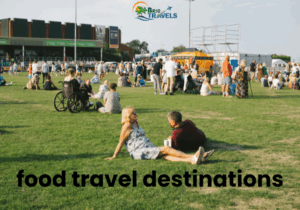Introduction: Discovering Dubai’s Old Town
The Old Town of Dubai demonstrates the depth of the cultural character of the emirate. The Al Fahidi Historical neighbourhood is a remarkable demonstration of the depth of the flourishing settlement along the banks of Dubai Creek. The narrow lanes and traditional wind-tower houses veil you in a sense of time before the recent rush of modernization.
The oldest part of Dubai is the Al Fahidi district and lays out some of the characteristics of how the emirate was constructed architecturally and culturally along with the rapid pace urban growth that has characterized the region.
The natural growth of the area and its preservation demonstrates the importance of holding onto historicism and retain historical values embedded in a city. Venturing through the alleys and on the tree lined streets of Al Fahidi, visitors can enjoy traditional markers, museums and Arabic coffee houses that have survived inevitable change.
Whether you are preparing for a visit or just curious about the history of Dubai, it is worth the time and effort to explore aspects of Dubai’s past in Al Fahidi. For future references as you plan a trip, contact the best travel agency in India and ask them to add this historic district to your Dubai tour package.
Chapter 1 – The Al Fahidi Historical Neighbourhood – A Glimpse of the Past
Historical Perspectives
The Al Fahidi Neighbourhood is primed to be described as one of the oldest areas of Dubai from the late 19th Centuries. The district was a major trade and cultural area, built by Persian merchants from Bastak, Iran. The neighbourhood has been developed and maintained for the sole purpose of preserving a piece of Dubai’s heritage in a time of continuous modernization.
Architectural Perspectives
The area is occupied by pre-modern wind-tower homes made of stone, gypsum, teak and palm wood. The structures would have been vented naturally and would have provided relief to the unbearable heat from the desert. The narrow alleyways and courtyards most definitely helped to design the historic environment, which gave the impression of walking through time and history.
Cultural Perspectives
It preserves former ways of life and traditions of the city of Dubai. Within its walls are housed many museums, art galleries, and cultural centres of the early periods of the emirate. These include the Sheikh Mohammed Centre for Cultural Understanding and the Dubai museum, which showcase some of the aspects of Emirati traditions customs, simultaneously with history.
Chapter 2: Traditional Markets – The Soul of Dubai Old Town
A Look at the Souks
The traditional markets or souks form the heart of Dubai Old Town. They’re not only a shopping experience, they’re a trip into the history of trading and and the development of Dubai’s culture over the centuries. A visit to these souks is a visit to the heart of old Dubai.
Spice Souk
The Spice Souk is truly a feast for the senses. A range of aromatic spices like saffron, cinnamon and cardamom excite the sensory function as visitors stroll by stalls filled with dried herbs and traditional medicinal options for sale. This is a place that has long served; for centuries this souk has served as a centre for trade and exchange.
Textile Souk
Across the creek, visitors can explore the Textile Souk with its rich offerings of materials. If your looking for silks, cotton and everything in between, you will be spoiled for choice and your options are practically limitless. The selection also includes traditional garments and scarves as well as a variety of other accessories. The experience adds additional authenticity and fun with the option to bargain.
Gold Souk
Finally, and perhaps the most stunning souk of them all, the Gold Souk. The displays of every possible type of jewelry imaginable glitter and sparkle in a manner that is truly dazzling. With over 300 total retailers, the Gold Souk offers a wide array of options. Gold plays a role in all Emirati cultural traditions, signifying wealth and status. To support and manage the competitions of quality and authenticity, there are lots of regulations.
Shopping Advice
Be sure to bargain in these souks. Bargaining is a traditional part of the activity and you are encouraged to bargain respectfully to negotiate the best price. it is wise to visit in the early morning or late afternoon, so the heat of the day is not an issue. If you are going to be planning a trip, the excellent travel agency in India should be able to help you customize Dubai tour packages that include these famous markets.
Exploring the souks of Dubai Old Town will provide you a fascinating insight into the history and tradition of local cultural marketplaces in Dubai.
Chapter 3: Museums – Preserving Dubai’s Heritage
Dubai Museum at Al Fahidi Fort
Dubai Museum, located in Al Fahidi Fort, takes you on an interesting trip through the development of Dubai. Dubai Museum was established in 1971 third to the opening of the museum is situated in the impressive Al Fahidi Fort, which dates back to 1787. The museum showcases items from the pre-oil era, including a number of enlightening artifacts and traditional tools and, models and backdrops which share life in the early days of Dubai. Visitors can wander through the fort and learn a little about Dubai’s history.
Sheikh Mohammed Centre for Cultural Understanding
The Sheikh Mohammed Centre for Cultural Understanding has a key role in embracing and promoting Emirati culture, customs and traditions. The centre presents an opportunity for visitors to interact with the local customs, traditions and religious practices in participatory sessions. The centre actively encourage dialogue, inviting guests to ask questions and learn about Emirati life. Located in the Al Fahidi Historical Neighbourhood, the centre goes beyond cultural understanding accommodating visitors from all parts of the globe.
XVA Gallery
XVA Gallery is an example of contemporary art in Dubai. The gallery is within a traditional building, which offers up more than just contemporary art in the context of traditional architecture, while celebrating the artworks of regional and international artists. The gallery is committed to providing a platform for creativity through contemporary art. The gallery features a cafe, providing art lovers with an oasis in which to relax and absorb their surroundings.
Other Noteworthy Museums
Aside from the big-name institutions, Dubai Old Town is also home to other cultural gems. The Coffee Museum showcases the historical and cultural significance of coffee in the Arab world along with tastings and workshops, while the Coin Museum features a large collection of coins and tells the economic history of the region. These museums add to Dubai’s cultural touchstone, providing different facets of the city’s heritage.
For any traveler who wants to see the cultural sites, a consultation with the best travel agency in India will create your own Dubai tour package. Best travel agencies in India will provide a package that covers all this historic and cultural sights that Dubai has to offer.
Chapter 4: Arabic Coffee Houses – A Taste of Tradition
The Cultural Value of Arabic Coffee
Arabic coffee, or qahwa, is a major part of the Emirati culture and is an incredibly important cultural value for the United Arab Emirates. Its making and serving is a tradition and part of the ritual that represents hospitality and respect.
The process of making it includes: roasting green beans, adding spices such as cardamom, grinding the mixture, and then brewing the mixture in a traditional pot known as a dallah. Offering coffee is considered an act of hospitality and is usually accompanied by dates as well. UNESCO recognizes the serving of coffee as belonging to the Intangible Cultural Heritage of Humanity is a representation of cultural heritage, but is more fundamentally a representation of the culture of generosity and community in the United Arab Emirates.
Well Known Coffee Houses
Arabian Tea House: The Arabian Tea House is in the Al Fahidi Historical Neighbourhood. You will enjoy a very genuine Emirati experience. The Arabian Tea House is a neighbourhood favourite where Emiraitis and touirsts alike enjoy a range of teas, breakfast brunches, and local dishes while sitting on traditional turquoise benches or white rattan chairs.
Coffee Museum Café
The Coffee Museum Café is located inside the Dubai Coffee Museum, and offers its guest a chance to sample different brews of coffee and purchase some unique coffee beans. The Dubai Coffee Museum tells the story of coffee, as well as its cultural and economic impact, highlighting the importance of coffee and the coffee industry and enhancing the sampling experience.
Coffee Etiquette
When offered Arabic coffee it is customary to accept the offer and give a slight nod. The host will then pour coffee into small cups until it is full up to half way. Visitors to these coffee houses gingerly sip their coffee; they relish the rich flavor. If you decline a refill, that may be viewed as rude; however, if you find you have had enough, you can gently move the cup back and forth to signal that you are done.
If you are interested in experiencing Dubai’s coffee culture, reach out to the best travel agency in India, and they can create Dubai tour packages that will include the time-honored coffee houses.
Chapter 5: Navigating Al Fahidi – A Walking Tour Itinerary
Recommended Route
Start at Al Fahidi Fort (the Dubai Museum). Then walk through the narrow alleyways of the Al Fahidi Historic Neighbourhood where you’ll find art galleries and cultural sites as well as traditional houses. After that, go for a more intense experience at the Sheikh Mohammed Centre for Cultural Understanding to expose yourself more in depth to Emirati traditions. To wrap things up, visit the Coffee Museum and try some Arabic coffee while you are there.
Time Commitment
Plan to spend about 45 minutes to an hour at each of your major stops. This should provide you with enough of an opportunity to wander through exhibits; interact with exhibits; and appreciate the experience at each location. You should be able to complete the impending walking tour in 3 to 4 hours if you are not rushed.
Local tips
Wearing comfortable, breathable clothes such as shorts and good shoes is key, as you will be walking and on uneven surfaces.
Bring a water bottle to refill; and keep in mind you’ll need additional hydration during the warmest time of day.
The cooler parts of the day for an excursion like this would be early morning or late afternoon.
Be on the lookout for hidden courtyards and small shops on your way through these alleys, as they often promote local art, experiences and some unique items for you to take away.
Accessibility
The Al Fahidi Historical Neighbourhood is easily accessible to pedestrians, with plenty of shaded areas and benches to rest. While generally accessible, the original housing may provide uneven flooring in some areas. You will find public restrooms and cafes throughout the neighborhood that will make your visit more comfortable.
For a wellplanned experience, it is suggested to explore Dubai Old Town through the Dubai tour packages offered by the best travel agency in India. Often times the packages will have guided tours which will allow you to take in the rich history and culture of the area without missing anything.
Chapter 6: Capturing the Essence – Photography Tips in Dubai Old Town
Best Spots for Photos
Al Fahidi Historical Neighbourhood, or Dubai Old Town, has many picturesque spots for photography. There are so many narrow, winding alleys and traditional wind-tower houses. Al Fahidi Fort is a great element of the scene.
Wrapped in sand-colored walls, the variation in light and dark shades on the walls can create exciting and dramatic looks in photos especially at morning and evening light. One almost forgets the picturesque sunset view with the Dubai creek and the traditional abras (wooden boat) nearby.
Photography Tips
Here are some ideas to add to the photos you will be taking:
Lighting: The golden hour is a period of time shortly after sunrise and before sunset when the sun is low and casts a soft, warm light that brings out both texture and subtle colours.
Angles: Low angles can help to enhance the dramatic look of the tall wind towers and narrow alleyways.
Equipment: While a great DSLR or mirrorless camera and a wide-angle lens are best suited for architecture, a smartphone with manual settings can provide more than adequate results too.
Considerate Photography
Although the architecture is superbly photogenic, I encourage you to considerately ask permission before photographing individuals. Always ask permission before photographing others, especially in culturally sensitive and/or religious situations.
Most cultures vary in their understanding of culturally sensitive places, and everyone should be considered to not photograph in their place of worship. Some traditions may also be more private than others as well. I also encourage you to ask locals and engage in conversation before taking any photos to respectfully capture their authentic activity and/or tradition.
If you want to see Dubai Old Town, we encourage you to reach out to the best travel agency in India to help you discover Dubai tour packages to make the most of your time there with guided photography tours to get the true vibe of the historical district.
Chapter 7: Where to Stay – Accommodations Near Al Fahidi
Al Seef Heritage Hotel: Part of Hilton’s Curio Collection, Al Seef Heritage Hotel puts you in an excellent location on Dubai Creek and anice blend of modern emirati design along with the comfort of a hotel – palm-wood ceilings, creek views, souk a few hundred meter away… and amenities like a rooftop pool, a spa and treatment rooms, and Middle Eastern classics in the hotel restaurant (Sabaa). Al Seef Heritage Hotel is the perfect base for exploring Dubai Old Town, being right next to Al Fahidi Historical Neighbourhood.
Budget options – If you’re on a budget, and want to stay somewhere decent near Al Fahidi:
XVA Art Hotel – This cool little boutique hotel, which is also a cultural space, is a restored courtyard house from the mid to late 19th-century and is quite lovely. The rooms have an artistic feel.
Arabian Courtyard Hotel & Spa – Close to Dubai Museum; comfortable accommodations and local sites nearby.
Citymax Hotel Bur Dubai – Are inexpensive and modern, and avery short distance from Al Fahidi.
Luxury – Here are some high-end options:
Sheraton Dubai Creek Hotel & Towers – This hotel is luxurious with nice rooms and overlooks Dubai Creek. Has a rooftop pool and nice dining options.
Address Grand Creek Harbour – The hotel has amazing skyline views from their rooms, and amazing amenities to the guests! The hotel is also a close distance from Dubai Old Town.
When planning your stay, it is advisable for you to get in contact with a travel agency in India, preferably a good travel agent, to check for Dubai tour packages that include accommodations near Al Fahidi, for a comfortable experience.
Chapter 8: Dining in the Old Town – Culinary Delights
Dubai Old Town is home to some local flavor and rooted in Emirati traditions as double Arabic culture. Food items such as Mandi (spiced rice and meat), Khuzi (lamb with rice and slow cooked), and Falafel (fried chickpea fritters), are found in almost daily diets. The food created here represents a continuation of history and consistency with cultural exposure.
Where to Eat
Al Fanar Restaurant
Al Fanar gives the diner a true sense of Emirati food and culture. The dining atmosphere takes you back to the 1960’s in Dubai and the experience is carried throughout the meal. Meals like Thareed Deyay (stewed chicken), Khoboz Raqaq (thin flat bread), share cultural history that visitors could certainly enjoy and learn from. It is a favorite spot for locals and tourists looking to satisfy their appetites or curiosity for traditional food from the region.
Local Restaurants
Small family run restaurants in the Al Fahidi neighborhood serve traditional food in informal settings. The level of hospitality exhibited by the owners is certain to provide a personal Tuscan experience and guide into Emirati daily living. The food is likely to be good and prepared with love so that you may enjoy hearty home-style meals.
Street Food
Traditionally prepared quick bite options are found among some of the current vendors in the souk environment, namely Shawarma and Samosas are usual find options choices. While you will be able to snack on food for your taste with these options, discovering these street food options will satisfy the traveling food lover in quick-bite style.
Dining Etiquette
When navigating through the Dubai Old Town culinary exploration environment, you may also want to consider the advice of the best travel agency in India, to find and secure your Dubai tour packages, that have culinary encounters as an appointment for your comprehensive visit.
Whether you’re dining at a restaurant or sampling street food, Dubai Old Town offers a culinary journey that reflects its rich heritage.
Chapter 9: Best Time to Visit – Planning Your Trip
Optimal visiting seasons
The ideal months for visiting Dubai Old Town are the colder months of late November to early April. The cooler weather makes it much more pleasant for strolling through the historic alleyways and attractions of Al Fahidi.
Cultural Events
Throughout the year, Al Fahidi has numerous cultural events highlighting and presenting Emirati traditions and giving visitors a taste of local music, dance, and crafts. These events help historians and tourists alike gain deeper insight into Dubai’s Heritage.
Avoiding Crowds
To avoid large tourist crowds visit Al Fahidi during the shoulder seasons of late November or early to mid-March. This will take advantage of good weather while limiting the tourism influx so you can view the Dubai Old Town at a leisurely pace.
Final thoughts: Enjoying the attractions of Dubai Old Town
As noted several times above, visiting the Al Fahidi Historical Neighbourhood is a fascinating way to gain an insight into ‘the way it was in the day’ in Dubai’s past. Recapping some of the offerings in this vibrant area – traditional souks, and museums, and peppered by coffee houses with aromatic brews. As one visitor wrote, “It felt like we had stepped back in time when we started walking through Al Fahidi – every corner present a story”.
You should you owe it to yourself to take your own heritage walking tour through Al Fahidi and discover the authentic, charming aspects of Dubai Old Town.









